Stephenie Liew, Year 2 Research.
Abstract:
To meet the rapidly growing global food demand, innovative agricultural methods that increase the efficiency of crop production are highly in need for testing and development. While plant growth is a multi-factoral case and standards vary for different species, theoretically, different light wavelengths should have stimulatory or inhibitory effects on plant growth, specifically Sweet Alyssum plants in its germination and intial growth phase. Additionally, plowed and unplowed soil were also tested as variables to find the optimal growing condition for Sweet Alyssum plants. Overall, depsite involving a small sample size and a relatively short growth period, Sweet Alyssum plants demonstrated a preferance for high humidity and unplowed soil for sprouting and initial growth. Though this experiment was unable to conclude the effects of blue and red light on plant growth, results showed that green light hinders plant growth and increases water evaporation from plants on sunny days.
Introduction:
As the global population continues to increase, methods and techniques in the agricultural industry have been rapidly developing to meet the growing food demand; by 2050, the world population is expected to exceed 9 billion in number, dramaticallly multiplying the burden on meeting global food demands (How to Feed the World in 2050). At present, various innovative farming approaches are designed in concern of the scarcity of arable land. Indoor farming, for instance, is a modern farming method that allows for both small and large scale crop-breeding in an indoor environment, which is more efficient in crop production, less susceptible to environmental effects, and allows for monitoring and regulating environmental controls or different aspects of plant cultivation (Indoor Farming – Global Market Outlook 2017-2016). This experiment is designed to test the effect of specifying the light wavelength and soil condition on Lobularia maritima, an annual flowering plant commonly referred to as Sweet Alyssum (Macdonald, 2014).
Visible light exists on a spectrum of different wavelengths, or different colours; on any coloured surface, the colour perceived by the human eye is the colour that the surface reflects while other colours are absorbed. For example, a red jacket appears to be red because all colours other than red are absorbed by the jacket while red wavelengths are reflected to the human eye (Wilson, 2000). Since all plants contain chlorophyll—a green pigment found in plants’ chloroplasts which accounts for plants’ green colour—theoretically, a green plant should reflect green light and should not be able to obtain necessary energy for photosynthesis (Holtzclaw, 2017). To create an environment where only light of a certain colour or wavelength is present, covers made from coloured hard plastic films were used to eliminate undesired light wavelengths—for instance, a green film will only allow wavelengths of green light to pass (Wilson, 2000). A total of three colours of light were tested in this experiment: green, the light that is, in theory, unfavourable for photosynthesis, as well as red and blue, both to be the most effective wavelengths for photosynthesis in green-leaf plants (Dickson, 2000). This experiment aims to prove the effect of limiting light wavelengths in a home setting and further test whether or not specific environmental controls will promote or hinder the germination and growth of Sweet Alyssum plants.
Sweet Alyssum plants were split into three experimental groups (Figure 1), in which their growth in green, red, and blue lights, as well as plowed and unplowed soil, was monitored.
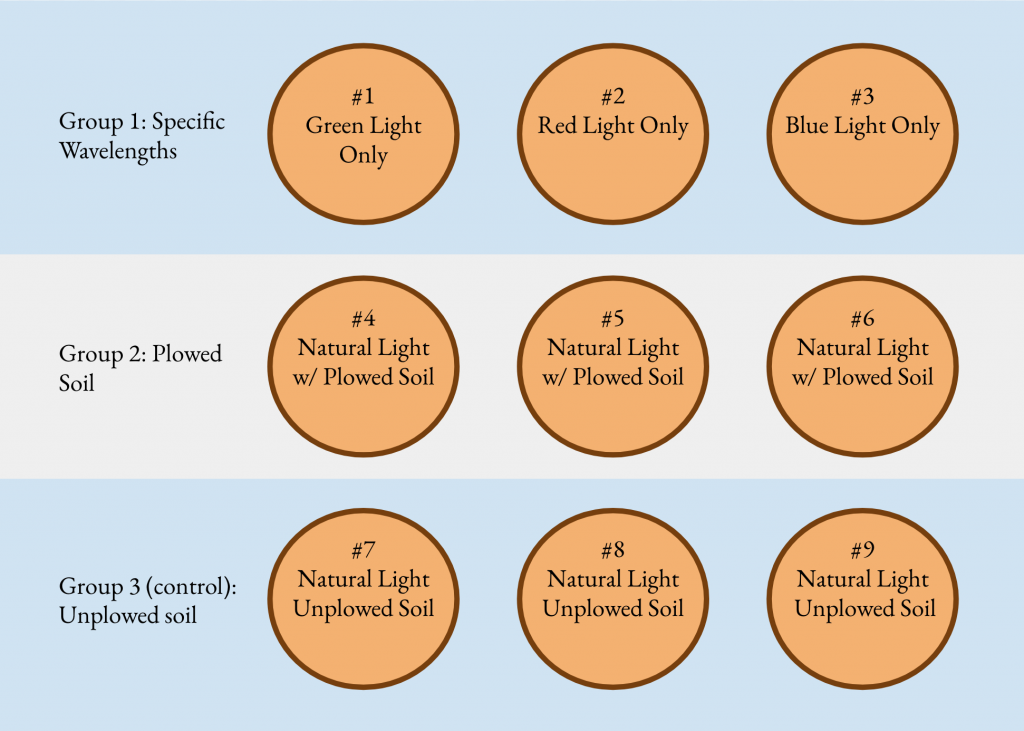
Fig. 1. Display of groupings of the experiment. Group 1 tests for plant growth in specific light wavelengths and unplowed soil; Group 2 tests for growth in natural light and plowed soil; Group 3 is the control group that tests for growth in natural light and unplowed (unaltered) soil. Each group contains three pots and are numbered as shown in the figure.
In addition to the light wavelengths, an additional variable–plowed and unplowed soil–was tested for their effects on Sweet Alyssum growth. Plowing, or tilling soil is a traditional agricultural practice commonly employed by farmers to induce plant growth as plowed soil is believed to enable an increased number of seed plantations, better oxygen circulation, and reduced amount of labour when planting (Will, 2015). However, according to recent studies, plowed soil may not be beneficial in all situations and can, in fact, suppress plant growth in some cases (Goode, 2015). While plowed soil allows for better air circulation, it also increases the rate of water evaporation due to the increased surface area in soil, thereby increasing the risk of plants drying on sunny days. In this experiment, groups with plowed and unplowed soil were also included to test for the most optimal growing conditions specific to Sweet Alyssum plants.
Materials and Methods:
Preparation
A total of nine 5 cm clay pots with draining holes were split into three experimental groups: Group 1 plants were treated with different wavelengths using coloured plastic films (transparent); Group 2 plants were grown in natural light and plowed soil; and Group 3 plants were controls planted in unplowed soil (Figure 1). For Group 1 plants, three cylindrical coloured plastic film covers were designed to substitute coloured lamps. Using coloured hard plastic films, a rectangular piece with an approximate length of 30 cm and a width of 13 cm and a circular piece with a 4.5 cm radius were cut out with sharp scissors. The two shorter sides (width) of the rectangular piece were then connected with clear tape, forming a right cylinder. The circular piece was then taped on one side of the cylinder. On the end without the circular top, four 6 cm ribbon-end shapes were cut out to allow for air circulation (Figure 2). These procedures were repeated to make three identical plastic covers in different colours (green, red, and blue).
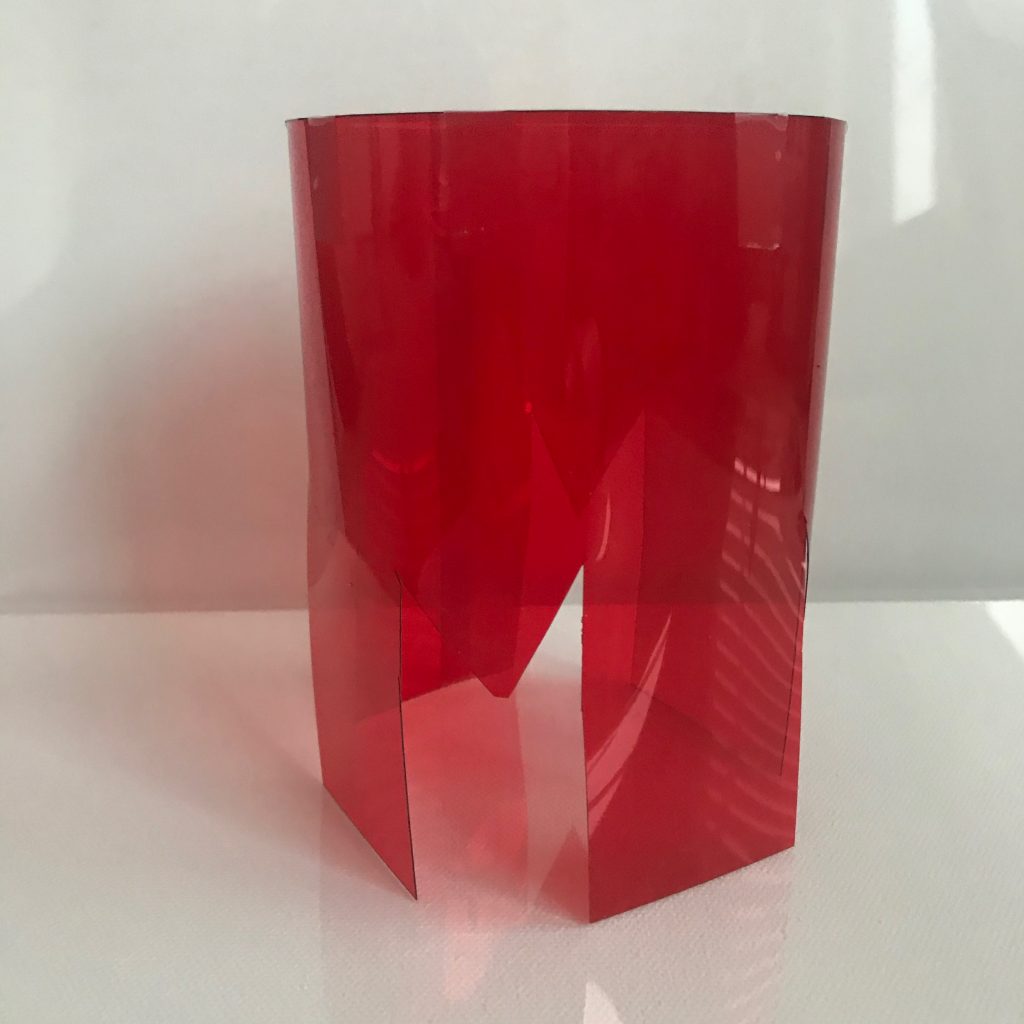
Fig. 2. Coloured hard-plastic cover (red). Covers of different colours (green, red, blue) were made for Group 1 plants to screen off undesired light wavelengths.
Planting
Each pot was labelled with a number from 1-9 using a Sharpie. The bottom of each pot was lined with half-a-piece of paper towel for water retention and the remaining space was packed with soil (Promix Premium Potting Mix) until almost full (Figure 3).
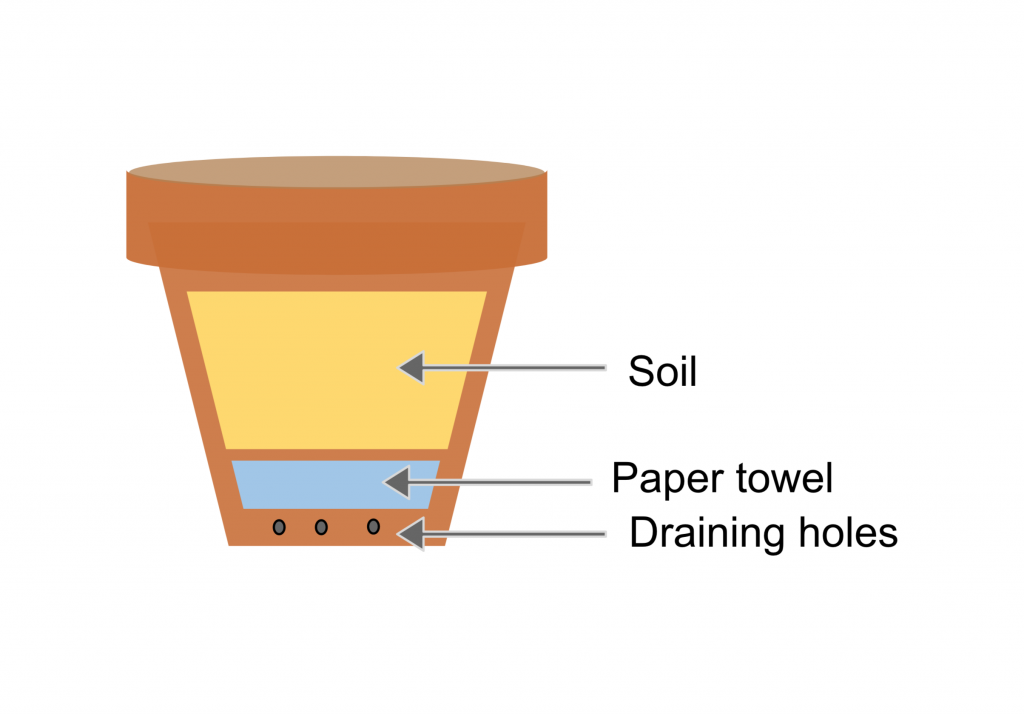
Fig. 3. Diagram of how pots were set up. Clay pots with draining holes at the bottom were used. Paper towel was lined at the bottom for water retention and the remaining space was packed with soil.
For each pot, an average of 70-90 Sweet Alyssum seeds (West Coast Seeds) was evenly sprinkled on the surface. The soil for each Group 2 plant (plants # 4-6) was then plowed—mixed slightly using a stick while the soil in the remaining pots (Groups 1 and 3) was not altered. With a spray bottle, each pot was sprayed until the soil was completely soaked with water (this step is specific to the planting phase and plants were not watered thoroughly in later steps). For Group 1 plants, plant #1 was screened with the green plastic film cover, plant #2 with the red, and plant #3 with the blue. The plastic film covers were removed each time when watering the plants and were placed back immediately afterward.
Growing
Sweet Alyssum seeds require light to germinate and should sprout in 5-14 days (Macdonald, 2014) . A spray bottle with fine mist was used to water each plant equally three times per day (morning, noon or early afternoon, evening). For this experiment, the plants were lined up on a windowsill in the basement of a house where adequate natural light is accessible (Figure 4). The room temperature was held between 20-22 °C and all windows were kept closed with the new air system being on 24/7.
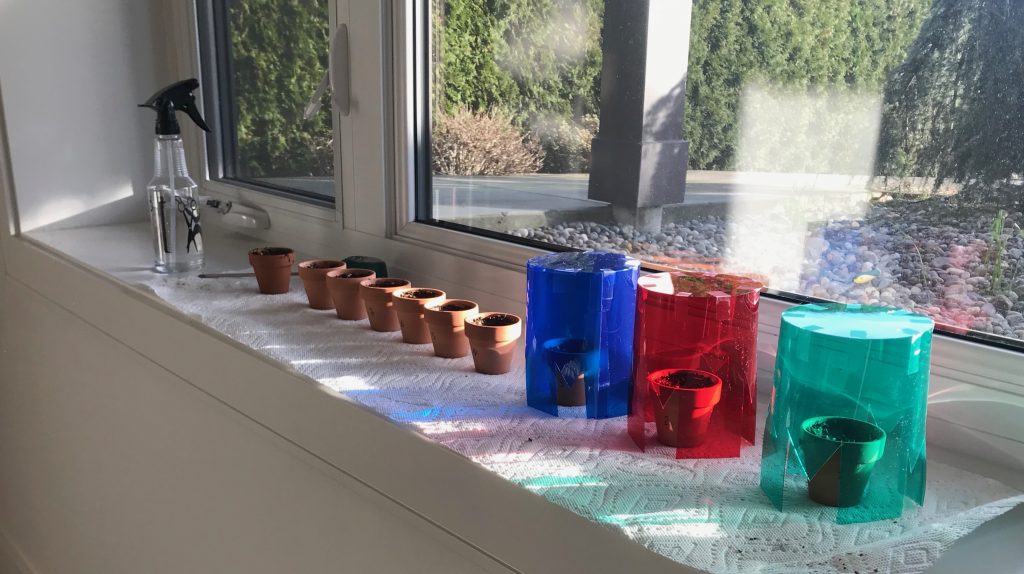
Fig. 4. Display of experimental setup and plant growing environment. All plants were aligned according to their numbers along a home basement windowsill where adequate natural light is present.
Data Collection
Over the course of the experiment, the number of germinations per pot were recorded every evening and photos of each pot (nine in total) were taken every two days for the analysis of plant growth trends. Moreover, an average plant height per pot and maximum plant height was also measured with a clear ruler and recorded every two days. Changes in weather and irregular changes in plant growth were also recorded in note form per appearance.
Results:
Plant growth was recorded over a period of 18 days to determine whether or not specific wavelengths and plowed or unplowed soil had an effect on Sweet Alyssum germination and initial growth. As presented in Figure 5, the growth trends in average plant height for Group 1 plants are shown individually as indicated by their line colours; while data for plants #4-9 was recorded separately, a daily average for each Group 2 and Group 3 was calculated.
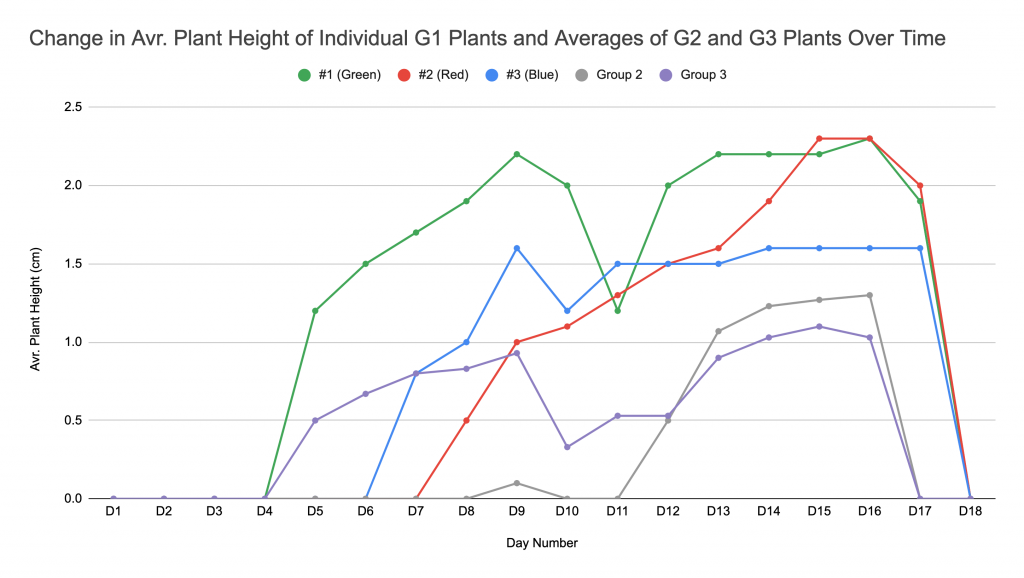
Fig. 5. Graph of the change in the average plant height of individual Group 1 plants and averages of Group 2 and Group 3 plants over time. Plants #1, #2, and #3 belonged to Group 1 (Figure 1) and are shown as individual trends. For a clearer expression of data, a daily height average was calculated for each Group 2 and Group 3 as shown in the graph.
The Group 3 plants and plant #1 germinated the earliest—all four plants sprouted on Day 4. Plant #3 then germinated on Day 6 and plant #2 on Day 7, leaving Group 2 plants to be the latest sprouting group—one round of Group 2 plants germinated on Day 8 and another round on Day 11 (Figure 6). Overall, plants in Group 1 had the greatest trend in the average plant height; specifically, plants #1 and 2 reached a maximum height of 2.3 cm and plant #3 reached 1.6 cm. The average plant height of plants in Groups 2 and 3 never exceeded 1.4 cm over the 18-day period.
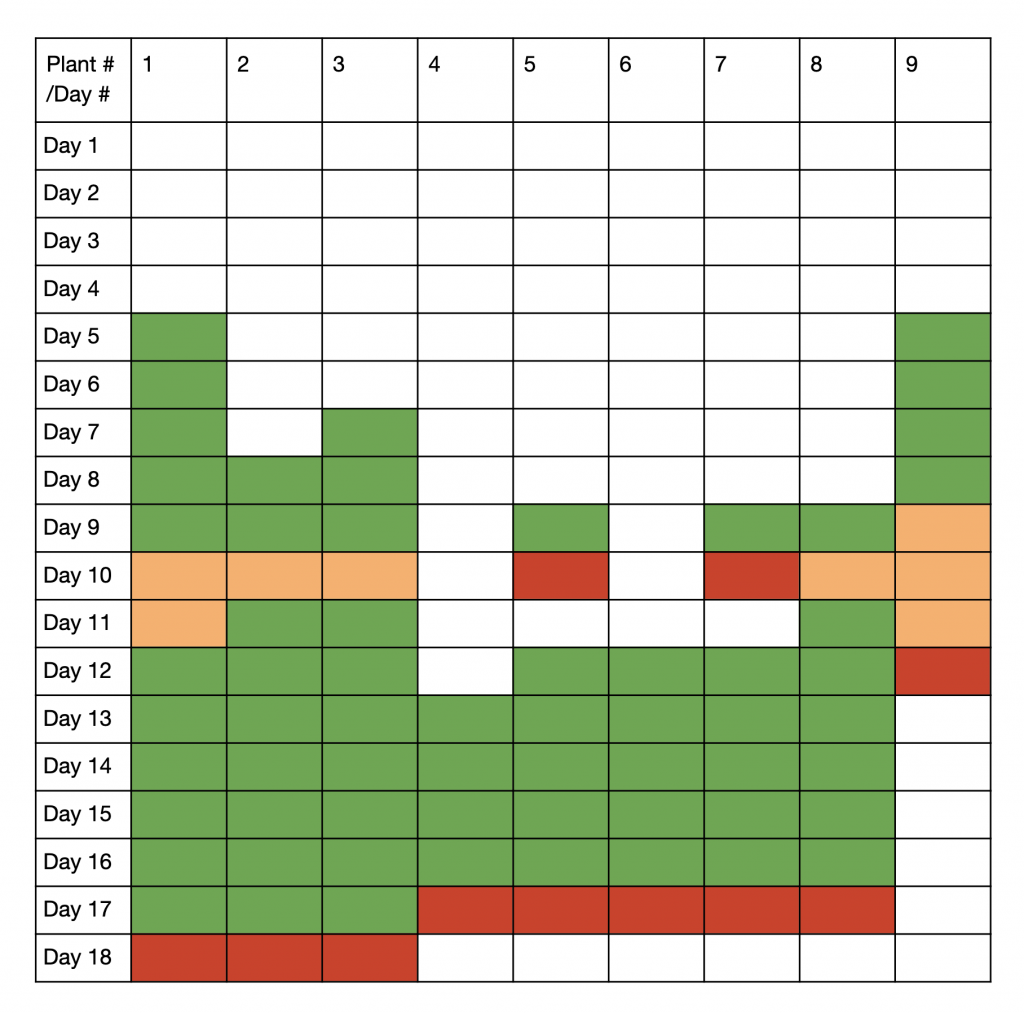
Fig. 6. Table of plant life span and condition over 18 days. Blank boxes indicate no growth; green boxes indicate plant germination or/and growth; orange boxes indicate loss in plant height; and orange boxes indicate death of all plants within the corresponding pot.
Over the course of this experiment, the weather was mostly rainy or cloudy and very little sunlight was available except for on Days 10-11 and 16-18. While the daily watering amount was controlled, a large percentage of plants lost height over Days 9-10 due to strong sunlight. A percentage in average height lost over Days 9-11 was calculated for each plant in Group 1: plant #1 (in green cover) experienced a height loss of 45.45%, plant #2 (in red cover) was not affected and increased 30.00% in height, and plant #3 (in blue cover) was slightly affected, decreasing 6.25% in height; the same calculations were applied to Groups 2 and 3, with results showing Group 2 plants losing all height (completely dried off) and Group 3 plants losing 42.86% in height (Figure 7).
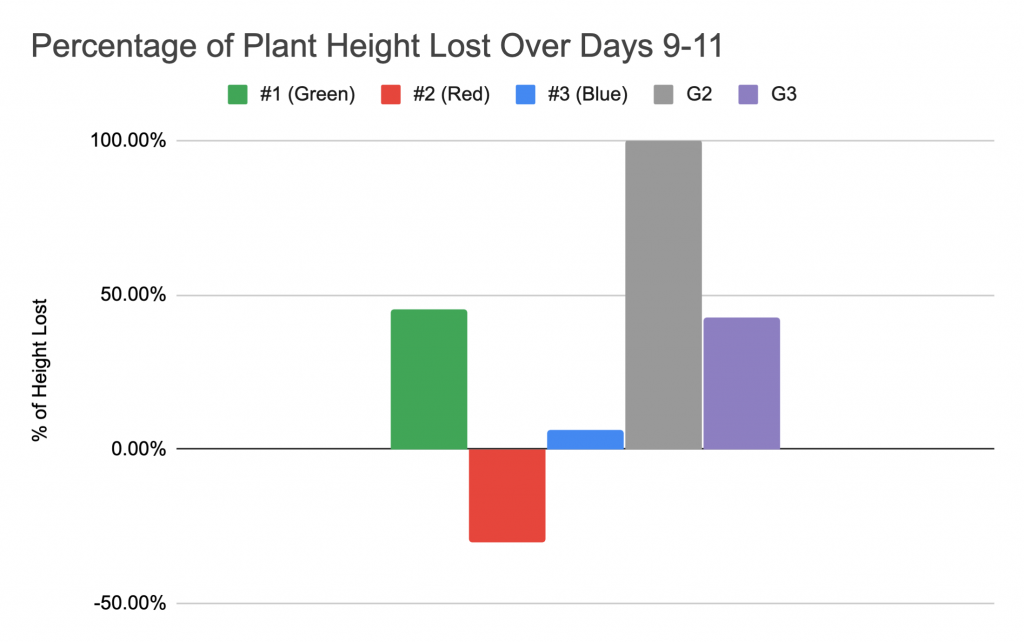
Fig. 7. Graph of the percentage change in plant height over Days 9-11. Group 1 plants (Plants #1, #2, and #3) are shown as individual trends while the average for each Group 2 and Group 3 is shown. A positive percentage represents a loss in plant height while a negative value indicates a plant increased in height instead of losing height.
Discussion:
The Group 1 plants showed the best overall growth trend, with all three plants reaching maximum heights over 1.5 cm. A minimal difference occurred between the average maximum height of Group 2 and Group 3 plants. As the three Group 1 plants that were grown in different wavelengths were compared, plant #1 (in green cover), whose growth should be, hypothetically, hindered, exhibited one of the best growth trends among all plants. As reflected in Figure 5, Group 1 plants—which all had plastic covers—had significantly faster and better growth trends. The more humid environment that the coloured plastic covers created was most likely accountable for these trends; although parts of the cylindrical cover were carved out for air circulation, the impermeable plastic cover increased the retainment of water, hence providing Group 1 plants with a more favourable germinating condition. This advantage also allowed all Group 1 plants to last one extra day compared to the other two groups: plants #1-3 died on Day 18 while plants #4-9 died on Day 17 (Figure 5). Despite these two prominent side effects of the plastic covers, they seem to show little impact in other growth stages.
By comparing individual plants within Group 1, it can be supposed that during its germination stage, plant #1 was not affected by the limitation of only being exposed to green light, actualizing the idea that Sweet Alyssum germination may be independent of light, or specific light wavelengths. Though Plant #1 exhibits a favourable growth trend over the majority of the experimental course, compared to other plants in Group 1, Plant #1 suffered greatly from detrimental effects on Days 10-11 when strong sunlight was present all day. Thus, to conclude, limiting the light wavelength to specific colours (green, red, blue) had a minimal effect on Sweet Alyssum germination and growth on days with little sunlight exposure, but had a significant impact on a plant’s ability to survive on days with strong sunlight.
In comparison between Group 2 and Group 3 plants (plowed and unplowed soil), differences were less prominent though still present. On average, compared to the Group 2 plants (grown in plowed soil), Group 3 plants (grown in unplowed soil) germinated four days sooner and experienced less damage on Days 10-11 when the strongest sunlight was present. This difference was likely due to the variation in soil surface area: more area of the plowed soil was more readily exposed in the air, thus speeding up water loss. Unplowed soil, on the other hand, had better ability in retaining water, therefore it was more favourable for plant growth.
The experimental group for this project was relatively small—only one of each colour was tested and each group only had three plants—so a larger sample size would be necessary for conclusions derived from this experiment to be confirmed. Due to budget limitations, coloured plastic covers similar to cases were used to screen undesired light wavelengths instead of using individual LED lamps covered with plastic films. This provided Group 1 plants with a more optimal growing condition, causing the results to be less reliable. In future experiments, individual lamps can be used if possible; transparent plastic covers of similar size and design can also be used for other plants to ensure a controlled environment. Lastly, since no device was available to test for light wavelength, it was assumed that each coloured plastic cover thoroughly eliminated all other colours of wavelengths except for the desired range. While this experiment could serve as an introductory step to testing optimal growing conditions of other plants or crops for maximum efficiency, further research on different light wavelengths could be done for a reversed effect. For instance, if a specific wavelength of light could productively inhibit plant growth, it could certainly be used for treating invasive plant species.
Overall, in the
germination and initial growth stages Sweet Alyssum plants, an environment with
high humidity and unplowed soil is favourable for plant sprouting and growth;
while it can not be determined whether or not growing Sweet Alyssum plants
under only blue or red light promotes plant growth, results showed that green
light hinders plant growth and increases water evaporation from plants on sunny
days. Since this experiment only covers a small sample size and one plant
family, more testing would be required to confirm these findings and to examine
whether or not aspects of plant cultivation tested in this experiment are
scalable for other plants or crops in agricultural practices.
References:
Dickson, Leal G. “Photosynthesis.” Life Sciences at the University of Illinois at Urbana-Champaign, Encarta Encyclopedia , 2000. Online. Retrieved Mar. 28th, 2020.
“Global Agriculture towards 2050.” High Level Expert Forum – How to Feed the World in 2050, Oct. 2009.
Goode, Erica. “Farmers Put Down the Plow for More Productive Soil.” The New York Times, The New York Times, 9 Mar. 2015.
Holtzclaw, Fred W., and Theresa Knapp Holtzclaw. Pearson Education Test Prep Series for AP® Biology. 11th ed., Pearson Education, Inc., 2017. Paper. Retrieved Mar. 26th, 2020.
“Indoor Farming – Global Market Outlook (2017-2026).” Research and Markets, July 2019. Online. Retrieved Mar. 26th, 2020.
Macdonald, Mark. “How to Grow Alyssum.” West Coast Seeds, 8 Sept. 2014. Online. Retrieved Mar. 6th, 2020.
“Why Do They Do That? – Plowing or Tilling Fields.” Iowa Agriculture Literacy, 23 Oct. 2019.
Wilson, Helen. “Light: Wavelength, Colour, Filters.” National Centre for Initial Teacher Training in Primary School Science, 10 Nov. 2000. Online. Retrieved Mar. 26th, 2020.